We all know them, we all need them and we have all been helped by them, but what are they actually called?
A mobile mechanic; “A skilled worker who repairs and maintains vehicle engines and other machinery”. I don’t think this is a particularly good description of the work they do.
A mobile fitter; “A person who puts together or installs machinery”. No, sorry, this doesn’t cut the mustard either and is an insult to their skills.
A mobile engineer; “A person, who designs, builds or maintains engines and machinery”. This is still nowhere near the skillset of the people I know in this role.
The closest I could get was a mobile service engineer; “A skilled person who visits equipment which is sometimes in remote locations”. They resolve or perform maintenance functions and assess, install and repair equipment or machinery.
However, considering the diverse challenges they have to undertake in sometimes extreme conditions to get us machine operators on our merry way, this title still doesn’t give them the credit that they deserve.
On a cold wet day it’s great to just jump into the cab, after a breakdown has been repaired, and crank the heater up. I have never given much thought to the fact that the engineers would continue to the next site and encounter more of the same horrible
conditions while I was nice and cosy. “It’s too wet” or “it’s too cold” are phrases I’ve never heard – they just get stuck in and get the job done regardless of the conditions or climate.
The engineers I have met and who have helped me have this “never give up attitude” and are usually capable of finding a solution to every problem they face.
I was extremely lucky to have been able to call on the services of one such person when I was operating a forwarder full-time. His name is Stuart Welsh and he is one of the three service engineers looking after the fleet of timber forestry equipment owned by Dick Brothers Ltd, a timber harvesting contractor.
I take my hat off to Stuart he is an exceptional mechanic, fabricator, hydraulic specialist, welder, diagnostic technician, electrical engineer, etc. I am sure you get the picture but unfortunately a lot of the time we take such skills for granted.
A few times in the past I have had a problem with my vehicle and I have gone to the main dealer to get it repaired. The vehicle is dropped off and you wait in reception with “free coffee and biscuits” (which you know will be included in the labour costs), and then the workshop manager comes through with a look on his face and you know bad news is coming. As he approaches he starts to shake his head and sucks a deep breath through his teeth (there must be a training school somewhere to learn this as it has
happened to me multiple times), announcing that your vehicle has a terminal illness and nothing short of an expensive transplant will save it. He then talks to you like a child with long, technical words for the problem and then, when you finally grasp what he is trying to say, you start to reap the benefits of spending time with people like Stuart. You are able to suggest possible solutions that they would never think of, which is inevitably followed by the “that could possibly work but we can’t guarantee it” speech. You are then able to tell the manager to go ahead as you know the work would not be undertaken if the solution was unsafe. Leaving the garage a lot sooner than expected with your bank account still usable provides a great feeling of satisfaction.
-
That’s a remarkable amount of work hours for a single machine, the Norcar 600 owned by Erkki Rinne is taken well care of, it even has the original Diesel engine.
-
Kieran Anders is a forestry contractor working in the lake district. His work involves hand cutting and extracting timber using a skidder and tractor-trailer forwarder.
-
It is not possible to eliminate chain shot, but there are simple steps that can be taken to reduce the risk.
-
Arwel takes great pride in the fact that the mill has no waste whatsoever, “the peelings are used for children’s playgrounds, gardens and for farm animals in barns in the winter and the sawdust has multiple uses in gardens and farms as well.
-
Timber hauliers need to encourage young blood in, and also look after the hauliers we have, we need make the sector a safe and positive place to work.
Find Us On
I recently spent the day with Stuart to understand an average day for a mobile service engineer. Although I have been luckily enough to know Stuart for many years, I had never asked him what made him choose a career in forestry equipment. I was interested to hear that he left school to become an apprentice car mechanic in Peebles; once qualified, he continued to work there until he saw a position available at the Forestry Shop in Beatock and decided to apply. He was successful in his application and looked forward to the new challenges that this position would bring.
As he enjoyed working on forestry equipment, when a vacancy arose at John Deere Forestry he again successfully applied. He found going to work each morning invigorating as every day brought new and different hurdles to overcome.
Unfortunately, in 2009 the recession hit the UK hard and much of the house building ceased – this had a detrimental effect on forestry as most forestry contractors were put onto quotas, causing serious repercussions for new equipment sales. Everyone started to tighten their belts including machine manufacturers, and Stuart was one of three mobile service engineers let go by John Deere Forestry.
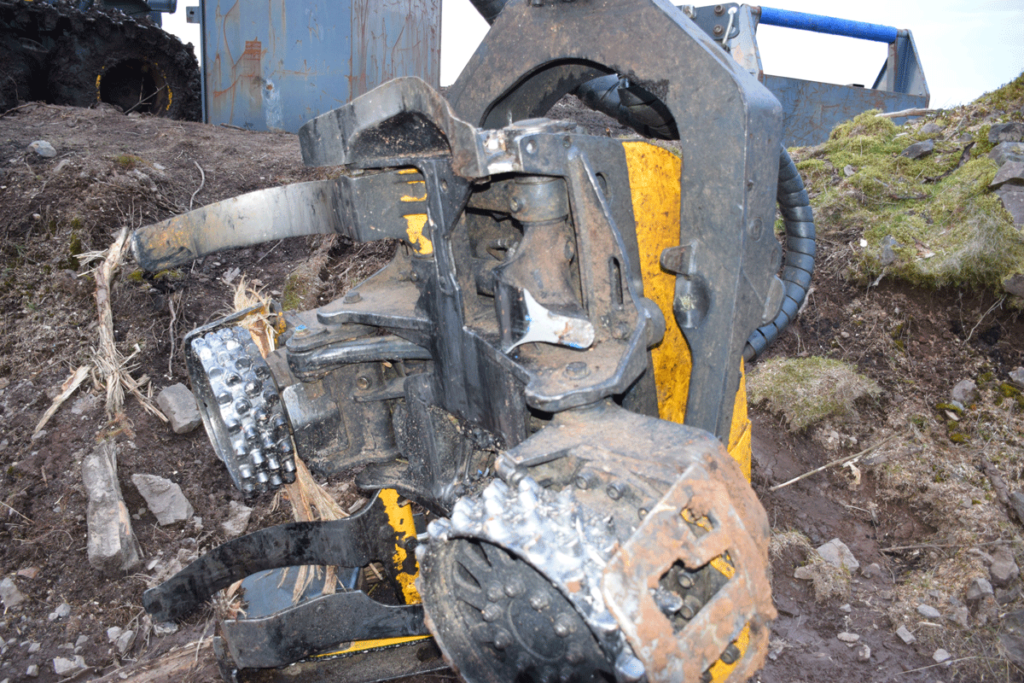
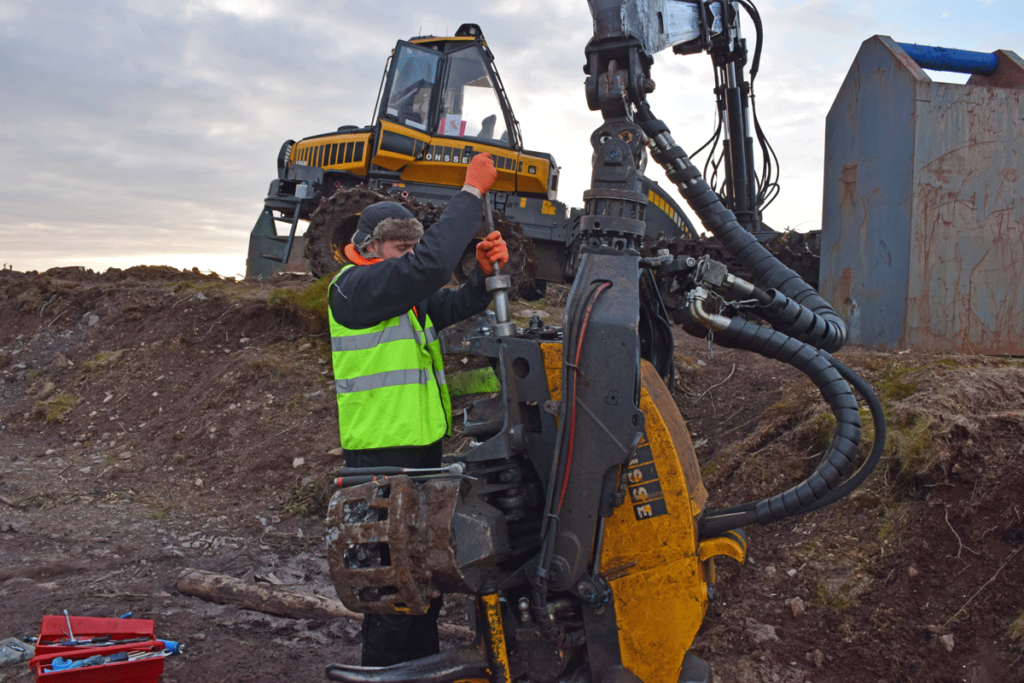

Luckily Stuart was able to find work as a car mechanic as employment opportunities in forestry at this period were non-existent. Although it wasn’t exactly what he had in mind, it was a useful stopgap until forestry found its feet again.
A new opportunity came up in 2012 working between Raymond Hall, forestry fabrication and engineering, and Dick Brothers Ltd, timber harvesting contractors, which he was eager to accept. He was delighted to be back amongst forestry equipment and relished the challenges each day brought. Over time, he found he was working more and more with Dick Brothers Ltd as they were taking on new machinery to keep up with the increasing demand for timber products and he soon had a full-time role.
Stuart is in his element amongst forestry equipment; even the bad days, lying in horrible, wet conditions under a machine where he feels some greater force is creating every obstacle possible to make the job as difficult as possible, do not dampen his spirits. He loves the freedom of the job, the variety of work and meeting different people every day. Forestry machines are continuously evolving with the latest technology and safety features and Stuart cherishes the fact that every day is a new learning day.
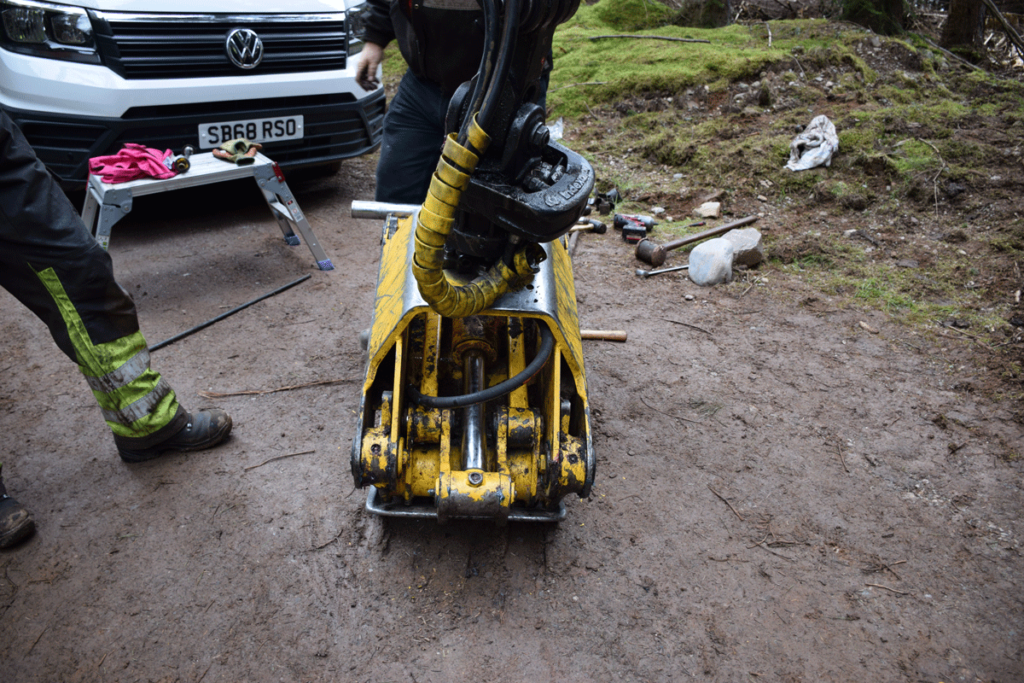
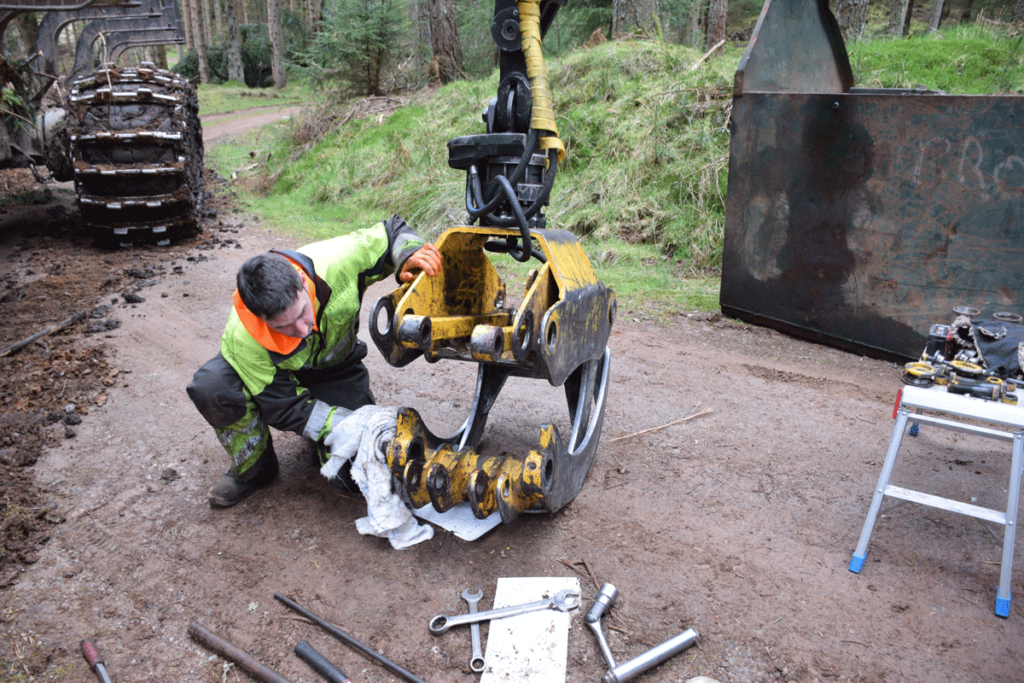
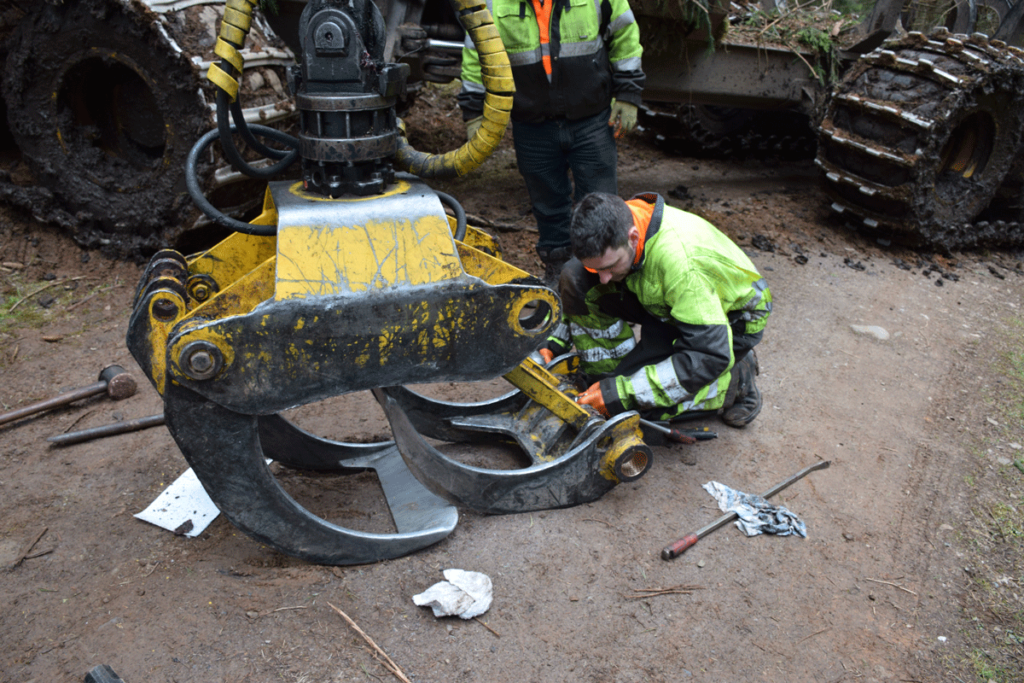
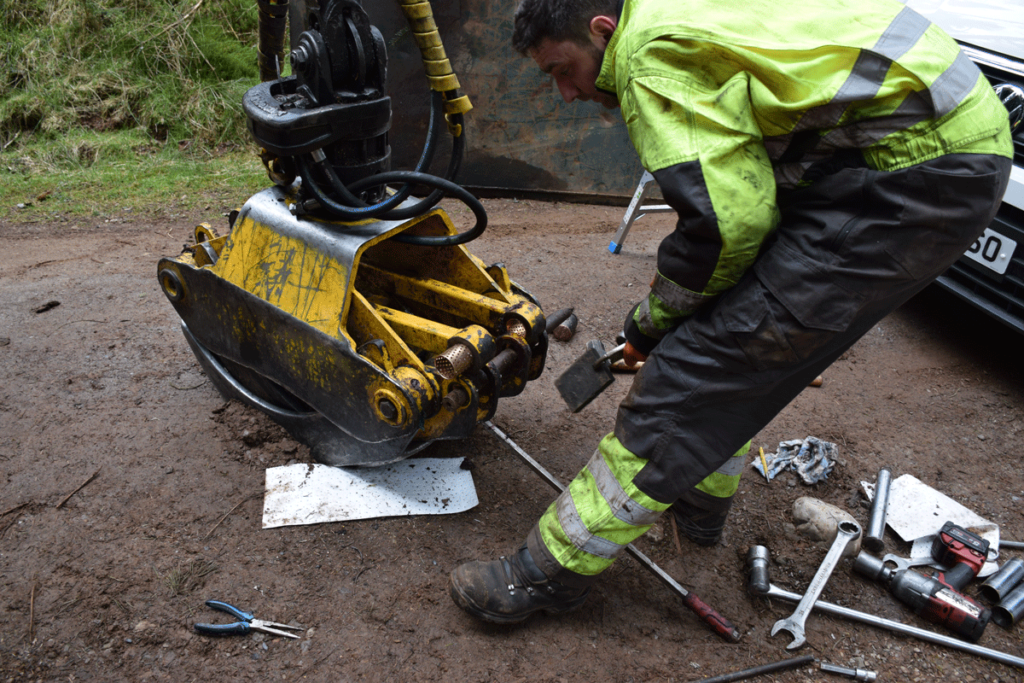
We met up at Stirling Services on a Monday morning as our first call of the day was in Carron Valley. It was a cold, sunny morning and we were off to replace a top knife on a three year old Ponsse Ergo. It was
being operated by Louris ?, but the old knife had
broken off and he was unable to work. The top knife on the Ponsse Ergo’s H7 harvesting head was a straightforward job with no hidden surprises and took about an hour.
Next on our agenda was to head over to Fintry, about 45 minutes away, as Stuart had a couple of jobs to carry out on a John Deere 1270G for operator Uldis Strods. As we approached the site we saw that Uldis was getting loaded onto Paul Millar’s low loader to move sites. Unfortunately there had been a change of plan but with no phone signal Uldis had been unable to let us know. This is a repair Stuart would have to return to later in the week so off we set to Dunkeld to re-bush a forwarder grapple.
It took over an hour to get there and there were a few
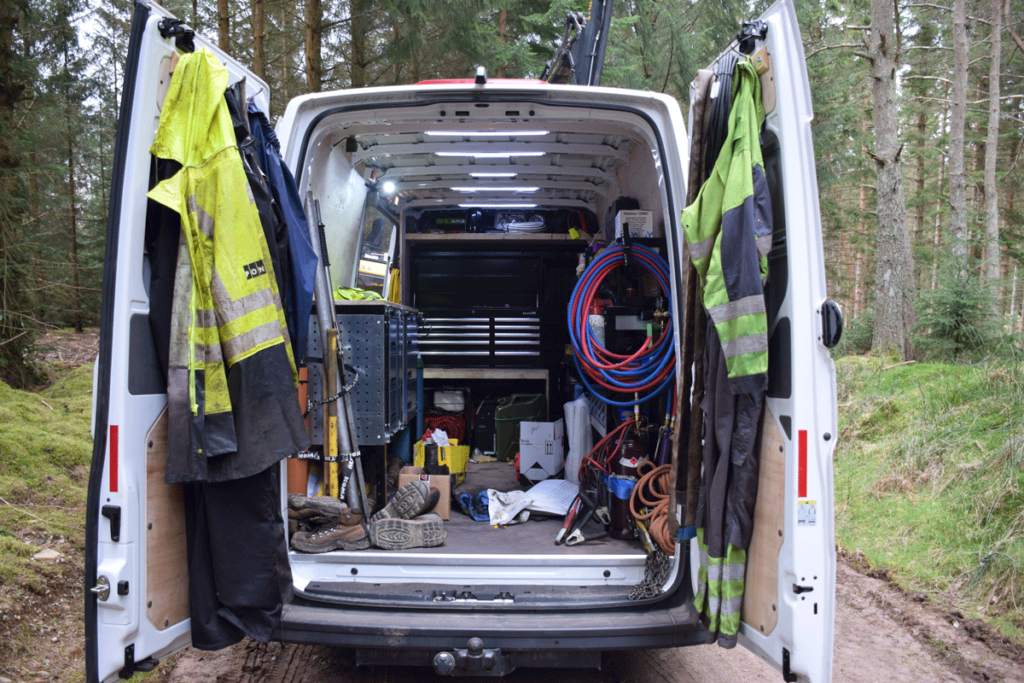
repairs to be carried out on the Ponsse Buffalo forwarder operated by Gavin McNicol. The first job was to replace the plastic bushes with new brass ones on the Hultdins .36 HD grapple, which is not the easiest job and involves a lot of physical work to knock out the pins and bushes. Once re-bushed, some heavy lifting is required to align all the pieces of the grapple for reassembly.
Gavin’s band tracks needed to be tightened but there was no point doing so as they needed to be removed. Gavin had been asked to secondary extract the wood to a collection point for the timber lorries and he would fit shorter joining links when he put them back on.
By the time we had gathered all the tools, it was after 2pm. Stuart’s next point of call was in Aberlour, Aberdeenshire where a Ponsse Buffalo was experiencing some drive issues (it lacked power when reversing). He was hoping to get up there at a reasonable time so he could get an early start on the machine in the morning. He had a few of repairs to carry out on two separate harvesters on Thursday so I arranged to meet him again then.
We met up at Allanton in the Central belt to go and see Uldis Strod’s John Deere 1270G, which had been moved from Fintry and was being used nearby.
The harvester was almost three years old and required new bushes in the measuring wheel. The weather was not as kind as on Monday we experienced rain, sleety snow showers and it was extremely cold on the fingers.
Uldis is not shy when it comes to using the grease gun and this makes Stuarts job much easier as the pins and bushes were knocked out easily. They are in an awkward position for obtaining much purchase on the hammer, so well-greased machines can greatly reduce the time Stuart

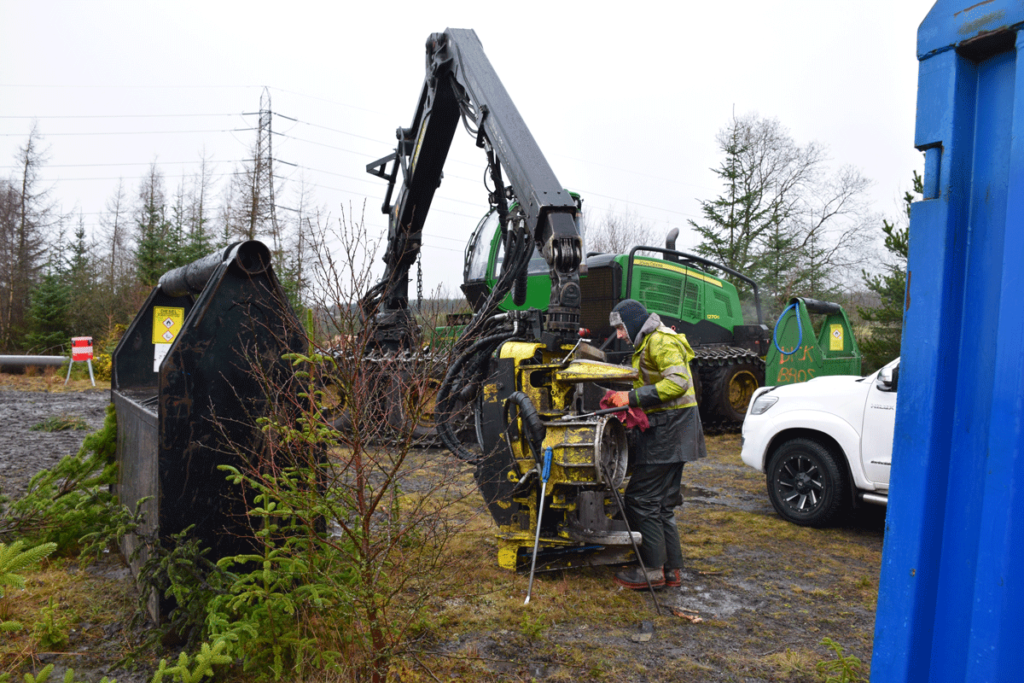
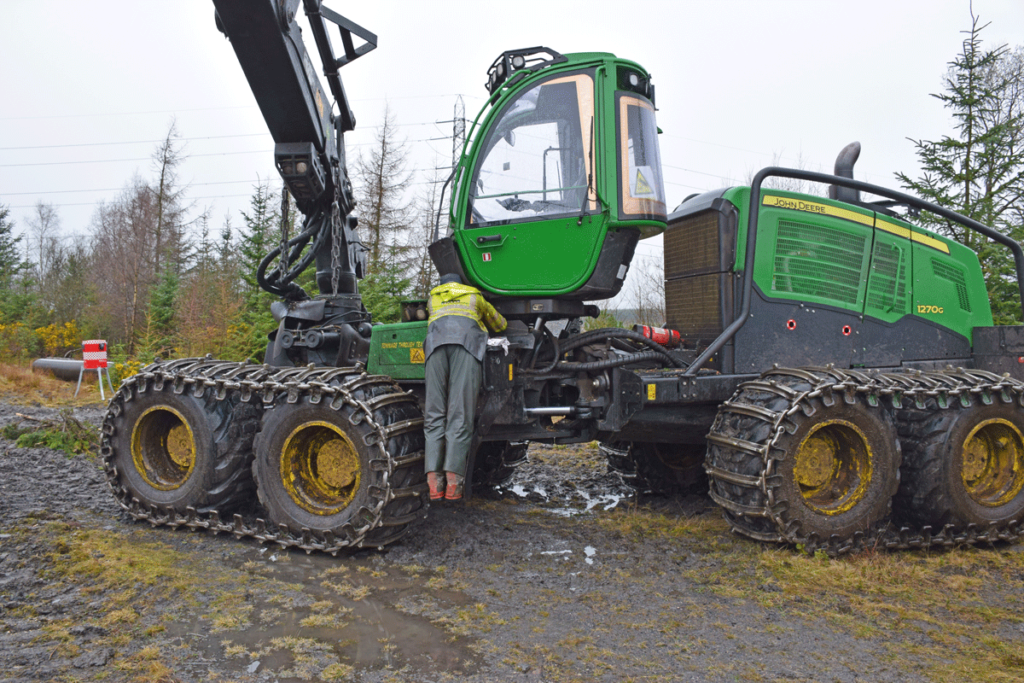

spends on each repair and the life of the components is also increased. The actual pin showed very little wear for its age on a highly productive harvester.
Next up was to fit a new gyroscope for the cabin levelling as the cab was never sitting at the proper level position during travelling and harvesting. It works along the lines of a spirit level sending a signal to the sensors in the rams, which will keep the cab level within its operating parameters.
The gyroscope was not too awkward to get to and didn’t take long to replace. The time consuming part was getting the oils on the harvester up to temperature on the cold morning so we could set the level to 0/0°.
It was good to catch up with Uldis again as I was the first forwarder to follow him when he joined the company approximately five years ago. He is an extremely good, productive operator who lays out the timber really well for the forwarder and can look after his machine. By the time we got everything gathered up and put away, it was almost 11am and time to head off to Whitelee Wind Farm near Cumbernauld for our final repair.
Reaching the forestry entrance took about an hour, but it then took well over 30 minutes on forestry roads to reach the site itself. Whitelee is the largest onshore wind farm in the UK with 215 turbines generating 539 megawatts of electricity. This is enough to power almost 300,000 homes, but they are still a bloody eyesore and a blot on our beautiful countryside – don’t get me started on that subject!
We were there to visit Graham Dow, who had one of the last John Deere 1470E (it is effectively a G series) harvesters.
First up was to replace the swivel joint that holds the hydraulic hoses in place where they join between the dipper boom and the harvesting head. The old swivel was completely worn out and on the verge of collapsing; the harvester had completed 5,300 operating hours.
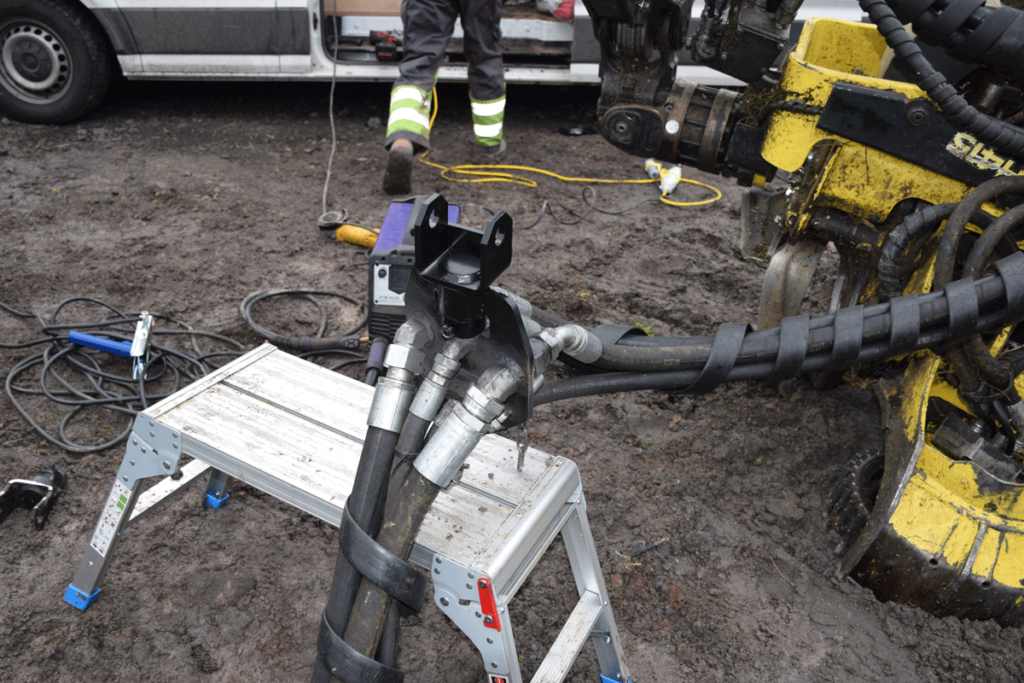


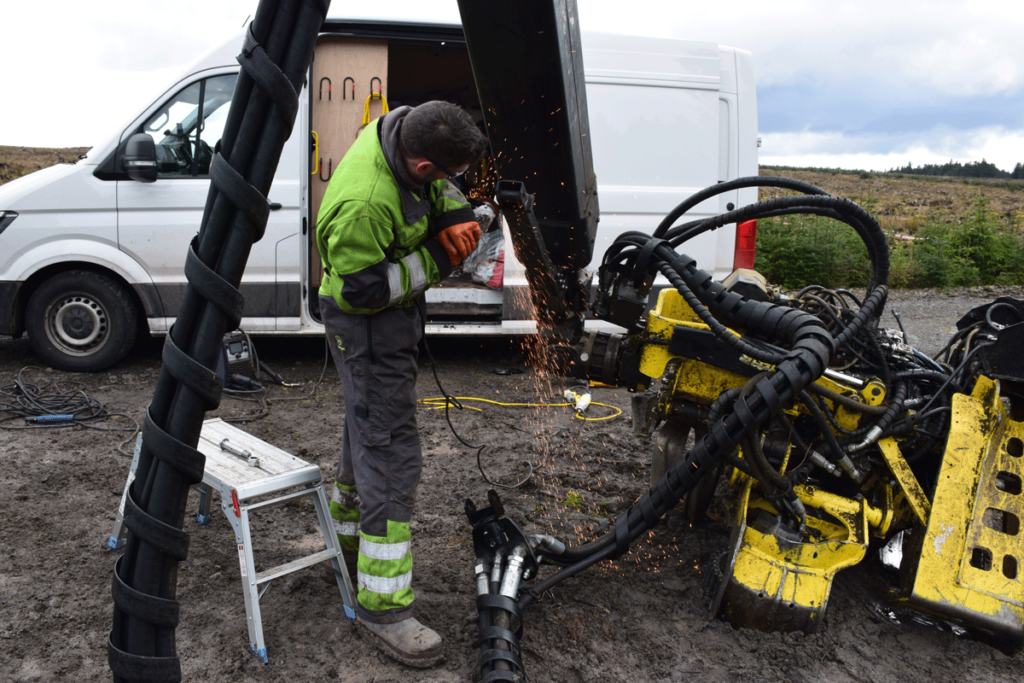
I thought Stuart would simply replace the complete plate, which would take quite a while as all the hydraulic hoses to the rotator and harvesting head would have to be removed from the old plate and refitted to the new one. However, Stuart had a much better and quicker solution in mind. He used a disc cutter to cut out the old, damaged swivel at the top of the old plate, cut out the new swivel from the new plate, and finally welded the new swivel to the old plate.
While the sleety snow had now stopped there was still a cold wind, and because of this Stuart was using his stick welder as opposed to his MIG welder, which is difficult to use in windy conditions. The complete job, including fitting the old plate back onto the boom, took little more than half an hour compared to probably a couple of hours fitting the new plate. When fitting a new plate it is sometimes a nightmare getting all the hoses to re-seal after being disturbed and there is also the added problem of containing, cleaning up and disposing of the oil spill pads from the hydraulic oil that inventively leaks out.
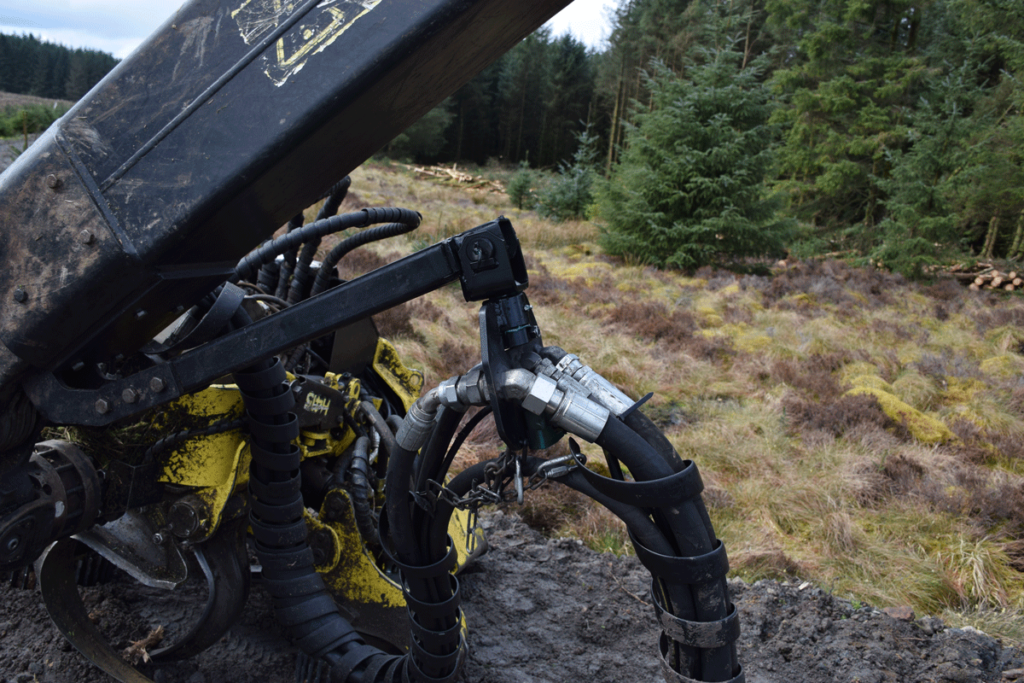
Also on our list was to replace the pins, bushes and ball joint ends on the top knife’s hydraulic cylinder on the H415 multi-speed harvesting head. These were the first ones to show signs of any wear and again it was good to see a well-greased head, which made Stuart’s job so much easier.
On inspection wear on the pins was minimal for the volume of timber that had been harvested; however, it is a much better and more cost effective option to replace them when they first show signs of wear.
Greasing machines regularly not only prevent wear on moving parts but also provide an opportunity to inspect the machine closely. Finding hairline cracks and signs of wear early is much better than a machine braking down due to a total failure of a component which could have been avoidable. Such failures can be time consuming and costly for both the owner and operator.
Graham is an operator who keeps on top of his harvester and is always on the lookout for any signs of wear or damage. He had noticed a bit of play on the dipper extension, which can increase the strain on the
crane’s slewing mechanism.
To eliminate this play it is necessary to replace the four plastic wear pads that are fitted on the end of the dipper boom, keeping the extension tight.
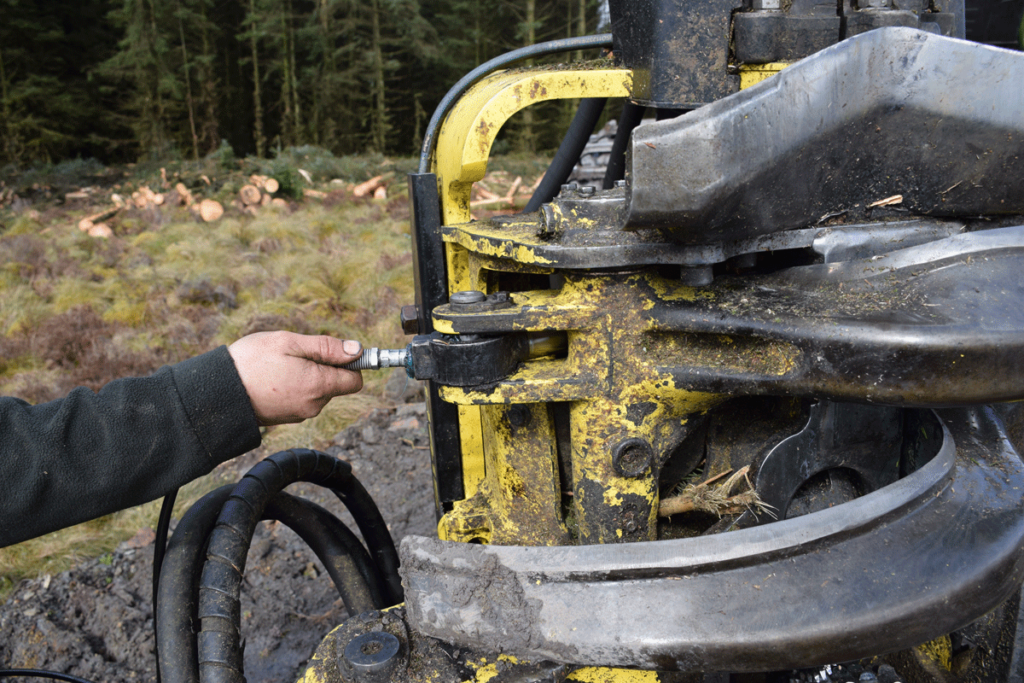
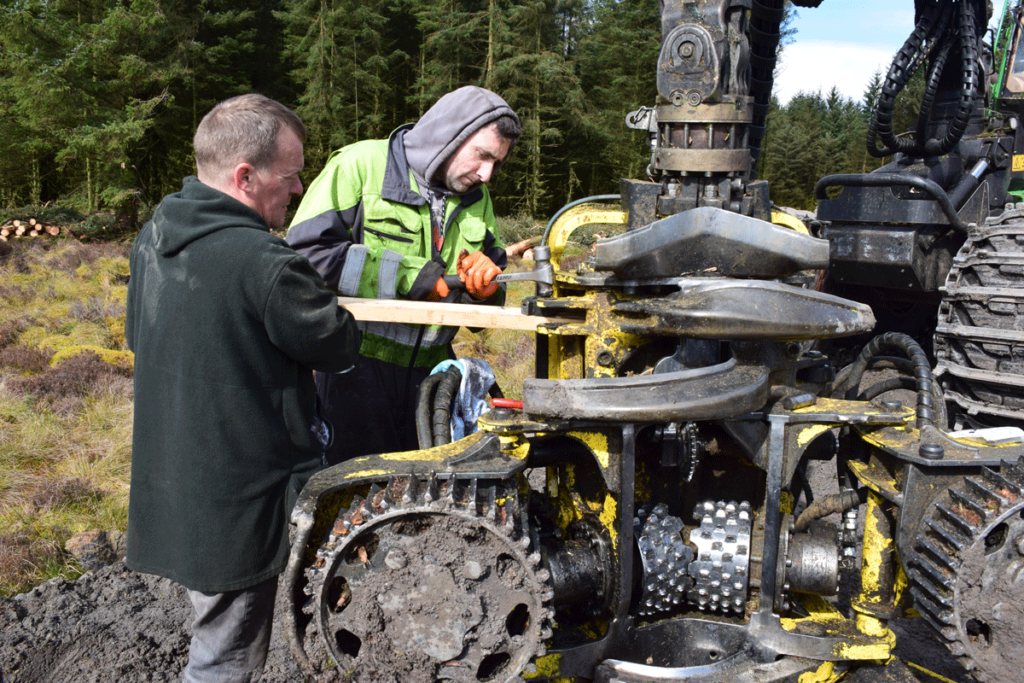

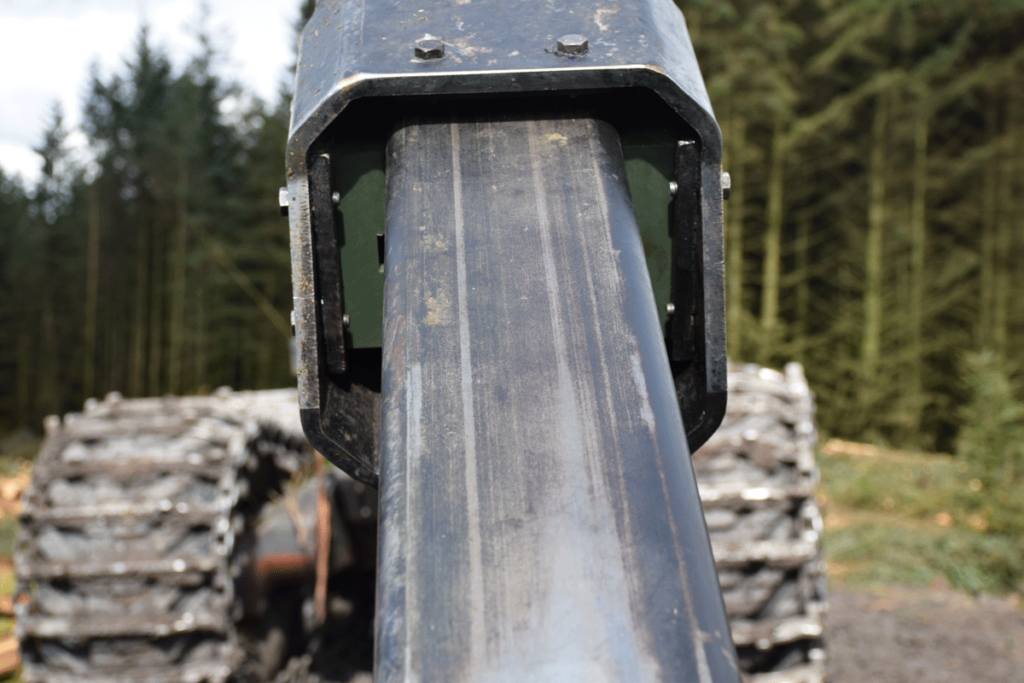
The first thing Stuart checked was that there was no damage to the four sides of the extension that could act as an abrasive on the wear pads. The metalwork was all good and he pointed out that the pads had very little wear considering the hours on the
harvester and volume of the trees he had processed. This was a trickier job to execute as the crane had to be positioned to take the weight of each pad we removed and replaced. The first one of each of the top and bottom and either side is not too difficult, but the second one is very tight to refit and can be difficult to position correctly.
Maybe it was my positive chi or the good teamwork of Stuart and
Graham, but the new wear pads were fitted quickly and without too much hassle. Graham tested the crane and was delighted with the results as there was no play whatsoever.
We had one last little job to complete before packing everything away and that was to weld Graham’s bar straightening press onto the top of his tool box.
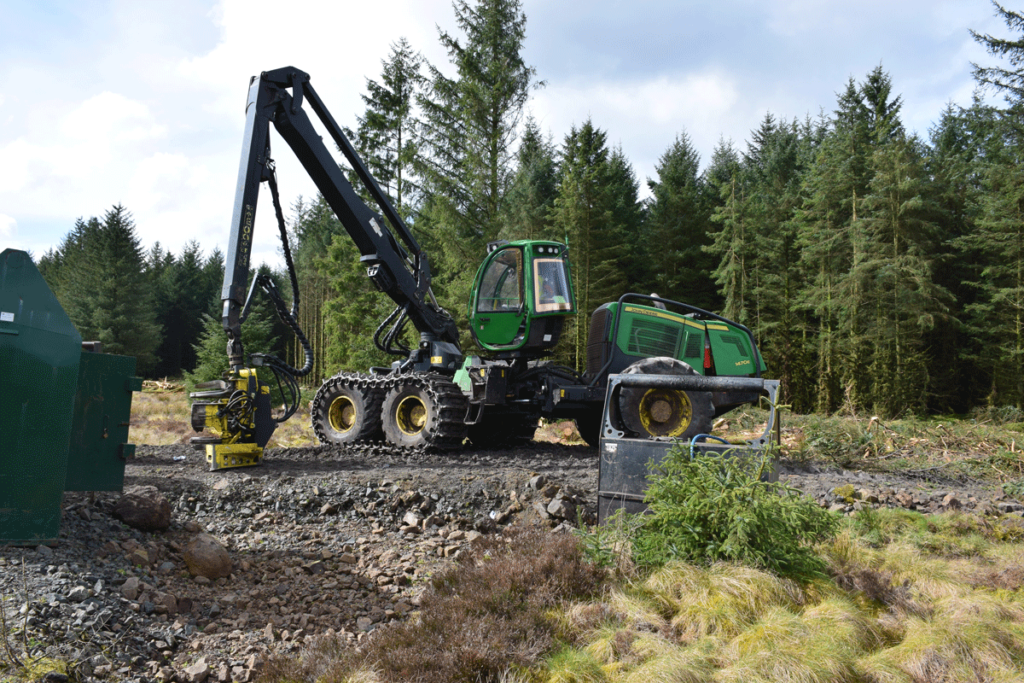
Once finished, it was time to get the flasks out for a quick cuppa before heading home. I had a great couple of days with Stuart seeing what his job involves with the added bonus catching up with some of my old colleagues.
I know all industries rely on teamwork to be efficient, but forestry is very different to other industries. We all generally try and work together and do our job to the best of our ability to make life as easy as possible for the next person in the chain. We have personal contact with a lot of the people involved and much of the time, rather than merely another cog in the wheel, they become close personal friends.
I have the utmost respect for Stuart and his fellow mobile service engineers; they go way beyond what is expected of them to keep the machines working and in excellent mechanical condition. Not only do they have all the difficult jobs to deal with on a daily basis but they need the patience of a saint to cope with the nonstop barrage of phone calls from operators with problems. I am sure, and I was guilty of this myself, that operators think they are sat in their vehicles simply waiting for a phone call which will see the service van arriving on site in minutes with flashing lights and sirens howling.
From all of us operators to all of the mechanical service engineers out there, we offer you our deepest gratitude and heartfelt thanks.
Forest Machine Magazine is written and edited by a forest professional with over 40 years hands on experience. We are dedicated to keeping you informed with all the latest news, views and reviews from our industry.
To support us you can subscribe to our bi-monthly magazine which is delivered to your door from only £30 per year.
Subscribe here
#homeoflogging #writtenbyloggersforloggers #loggingallovertheworld
-
 Issue 32£6.00
Issue 32£6.00


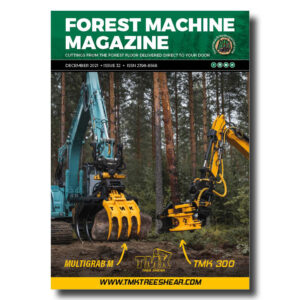
Stewy Welsh, top lad, always got on well from when I joined JDF, until he was released. Then he came back on the scene as a field service engineer with Dick Bros, regularly visiting Carlisle for required parts to effect repairs to Deere machines in Dick’s fleet.
Can’t speak too highly of him.
Maughan ex JDF , Carlisle, retired.